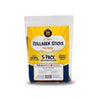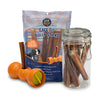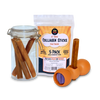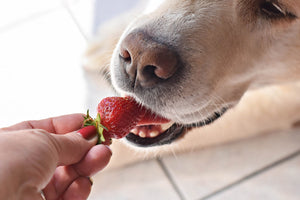When you’re enjoying a juicy strawberry, it’s natural to wonder if your pup can share in the delight too. The short answer: yes, dogs can eat strawberries, but only under the right conditions. In this guide, we’ll walk you through the benefits, risks, correct portions and how to safely and confidently give strawberries to your dog.
What Are the Benefits of Strawberries for Dogs?
Strawberries bring more than just sweetness to the table. For dogs, strawberries offer several nutrients and healthy benefits, including:
- Antioxidants and vitamin C: Strawberries contain compounds that support cell health and immune function.
- High water and fiber content: Water helps with hydration, and fiber supports digestion.
- Low calorie appeal for treats: Compared to many human snack foods, strawberries can be a smarter “sharing” choice when portioned correctly.
- Potential dental support: Some sources note that strawberries contain malic acid, which may help with tooth-whitening effects, though this is not a substitute for dental care.
When fed occasionally and in small quantities, strawberries can be a healthy, fun treat that complements a balanced diet.

What to Watch for and What Are the Risks?
As with all human foods shared with dogs, there are caution flags to keep in mind:
- Sugar content and portion size: Strawberries contain natural sugars. If given too often or in large quantities, they could contribute to weight gain, dental issues or upset stomach.
- Choking hazard and size issues: For small dogs especially, large pieces of strawberry, stems or leaves can pose a risk.
- Plant parts and additives: The leaves, stems or unwashed fruit may contain pesticide residues or be harder to digest. Also, processed strawberries in syrup or with artificial sweeteners like xylitol can be dangerous.
- Allergic reactions or digestive sensitivity: While rare, dogs may react to new foods in unexpected ways. Start slowly and observe.
Keep in mind that strawberries are not a substitute for a proper diet. They are a treat—not a food that replaces complete and balanced dog nutrition.
How Many Strawberries Can a Dog Eat? Portion Guide
One of the key mistakes pet parents make is assuming any amount is safe. The correct amount depends on your dog’s size, diet and overall health. Here’s a rough guideline:
| Dog Size | Suggested Serving |
|---|---|
| Extra-small (under 20 lbs) | 1–2 small slices or pieces |
| Small (20–30 lbs) | 2–3 slices |
| Medium (30–50 lbs) | 4–6 slices |
| Large (50+ lbs) | A small handful of pieces |
These are rough estimates. Importantly, treats (including strawberries) should not exceed about 10% of your dog’s daily caloric intake. If you’ve never given strawberries to your dog, start with one small piece and wait 12–24 hours to make sure no negative reaction occurs.

How to Safely Serve Strawberries to Your Dog
How you feed a treat is often just as important as what you’re feeding. Use these best practices to keep strawberries safe and enjoyable for your pup:
- Wash thoroughly to remove dirt, pesticide residue or mold.
- Remove stems and leaves, as they are tougher to digest and may cause stomach upset.
- Cut or mash into bite-sized pieces, especially for smaller dogs. For very small breeds or puppies, consider mashing or pureeing.
- Serve fresh or frozen only. Frozen slices can be a refreshing treat on a warm day. Avoid any berries with added sugar or xylitol, including canned berries, syrup-soaked strawberries and strawberry yogurt.
- Introduce gradually. After the first small piece, monitor for vomiting, diarrhea or increased thirst or itching. If you notice any of these, stop and consult your veterinarian.
What to Remember About Dogs and Strawberries
Dogs can enjoy strawberries as a tasty, nutritious treat. But the key word is moderation. Treat strawberries as an occasional snack, prepare them safely and always observe your dog’s reaction.
If you follow those rules, strawberries can be a fun addition to your dog’s treat rotation—bringing a bit of flavor, texture and nutrition to your pup’s day. That said, they’re just that: a treat. The foundation of your dog’s diet should still be balanced, species-appropriate dog food, and any major dietary changes should be done in consultation with your veterinarian.
When in doubt, ask the vet. If your dog has any underlying health issues, you might want to skip or tailor human treats like strawberries. A little preparation and caution go a long way toward keeping treat time safe and enjoyable.
Happy snacking for you and your pup!
Frequently Asked Questions
Can puppies eat strawberries?
Yes, puppies can eat strawberries, but wash, remove stems and leaves, cut to size and serve only small amounts. Puppies often have more sensitive digestive systems, so start extra cautiously.
Can dogs eat strawberry yogurt?
No. Most flavored yogurts contain added sugars, artificial sweeteners or other ingredients that may be harmful to dogs. If you really want to combine strawberries and yogurt, use plain, unsweetened, xylitol-free yogurt and mix in a small amount of plain chopped strawberries.
Are strawberry leaves, stems or green tops safe?
While not considered toxic, stems and leaves are not recommended because they’re harder to digest and may cause digestive issues. It’s best to remove them before offering strawberries to your pup.
Are there dogs who should not eat strawberries?
Yes. Dogs with diabetes, weight issues, dental problems and very small toy breeds should avoid sugary treats like strawberries or eat only minimal amounts under veterinary guidance. Also, dogs with known food sensitivities or allergies should avoid new foods unless approved by their veterinarian.

















